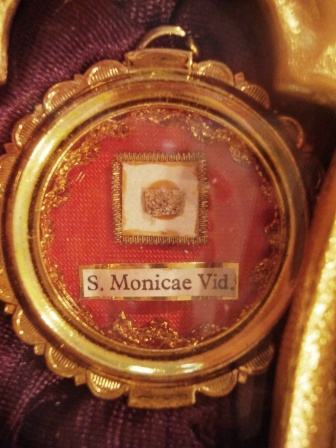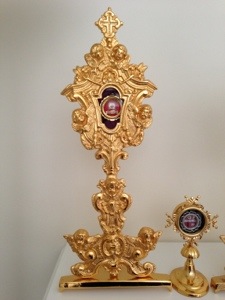In the older, traditional Roman calendar today is the feast of the mother of St. Augustine, St. Monnica, widow. She died in Ostia (Rome’s port) in 387, when she and her family were heading back to North Africa after Augustine’s conversion and baptism by St. Ambrose. She caught a fever during a blockade of the port.
(Yes, you can spell her name “Monnica”, more consistent with her Punic origins.)
In the chapel of The Cupboard Under The Stairs I have a first-class relic of this marvelous woman.
In the post-Conciliar calendar, her feast was moved to be next to that of her son.
As she lay dying in Ostia near Rome, Monnica told Augustine (conf. 9):
“Lay this body anywhere, let not the care for it trouble you at all. This only I ask, that you will remember me at the Lord’s altar, wherever you be.”
She was buried there in Ostia. Her body was later moved to the Church of St. Augustine in Rome across the street from where I lived for many years.
May she pray for us, for widows and for parents of children who have drifted from the Church.
Be sure to pray for the departed. Pray for them! Don’t just remember them. Don’t just think well of them. Don’t just, as the case may be, resent or be angry at them. Pray for them!
Prayer for the dead is a spiritual work of mercy.

 Also, I’ll remind you of a newish book on Augustine:
Also, I’ll remind you of a newish book on Augustine:
REVIEW: The book on Augustine which Pope Benedict would have wanted to write.
Also, if you want a really interesting book on the Doctor of Grace, check out Serge Lancel‘s volume. UK HERE
BTW… read about how here original epitaph inscription was found by some kids. HERE





































And here in the UK, it the feast of our wonderful English and Welsh martyrs. We are so privileged to have such patrons.
May she pray for us, for widows and for parents of children who have drifted from the Church.
And for wives of stubborn unbelieving men.
Dear St. Monica, pray for my husband’s conversion.
As a wayward son who was brought back to the faith primarily by the prayers of my parents to Our Lady, I wonder if praying for St. Monica’s intercession is the way to go or rather if it would not be more effective to imitate St. Monica herself. Somewhere St. Bernard says that given that Mary is all powerful with Our Lord, why would we pray to any other saint? a counsel that St. Monica herself seems to have anticipated.
A bit of recent research developed the following Augustinian tradition about St. Monica. To my mind it is very instructive for parents concerned about the eternal salvation of their children, instructive about where to turn for help. From the Augustinian website:
“In Augustinian tradition the particular devotion to Mary under the title of Mother of Consolation appears to have sprung from two different sources. both originating from a mother’s distress over a son in danger. The earliest story has been treasured by the Order of Saint Augustine. It tells of Saint Monica in the fourth century, distraught with grief and anxiety for her wayward son, Augustine, confiding her distress to the Mother of God, who appeared to her dressed in mourning clothes but wearing a shining cincture. As a pledge of her support and compassion, Our Lady removed the cincture and, giving it to Monica, directed her to wear it and to encourage others to do the same. Monica gave it to her son, who in turn gave it to his community, and so the Augustinian devotion to the wearing of a cincture as a token of fidelity to our Mother of Consolation came into being. In the sixteenth century the flourishing devotion gave rise to the Confraternity of the Cincture and to the popular picture of Mary with the Child Jesus, who holds the end of the cincture in his right hand.”
http://osa-west.org/our-mother-of-consolation.html
About the cincture I know nothing, but devotion to Our Lady under the title of Our Lady of Consolation I discovered at Our Lady of Consolation Brigittine Monastery in Amity, Oregon, the only monastery of Brigittine monks in the world. They follow the Rule of St. Augustine, hence the connection with the Consolatrix.
She is now as she was in St. Monica’s time, compassionate and attentive to our prayers—dulcis, clemens, pia.
What a marvelous example St. Monica set in her incessant prayers for her fallenaway son! Yet, I fear that too many parents of today have a kind of quietist approach to their son’s or daughter’s fall from grace and faith. “They will come back . . .” Will they? Who is praying for them? or rather, who is praying for them as if it mattered, as if Heaven and Hell were hanging in the balance?
Another anodyne: “The Lord is merciful. . . ” Yes, he is also merciful to the citizens of Heaven and will not let the wretch your child has made of himself to be a blot on the festivities, of that we may be sure. God is merciful, but not without repentance from sin, without your son or daughter doing a complete about-face. And for that someone by his prayers and sacrifices must bring down grace from Heaven.
One would like to say to such parents, “If not you, if you will not put yourself out, who will? If you are not going to be “Monica” how can your child ever be “Augustine.” Where are your daily Masses for him, your rosaries, your novenas, your incessant knocking on the gates of Heaven?”
At one point Monica went to a bishop to ask him to speak to her son, but he would not, saying that Augustine was not ready to listen. From his Confessions:, “Which when he had said, and she would not be satisfied, but urged him more, with entreaties and many tears, that he would see me and discourse with me; he, a little displeased at her importunity, saith, “Go thy ways and God bless thee, for it is not possible that the son of these tears should perish.” Which answer she took (as she often mentioned in her conversations with me) as if it had sounded from heaven. ”
(https://www.gutenberg.org/files/3296/3296-h/3296-h.htm)
One can only wonder then if the Heavenly verdict on so many of our fallenways would rather not be, “It is not possible that such a neglected, abandoned child should live.”
Reading between the lines of what amounts to a mass apostasy, one can only wonder if it is not permitted (and God only permits evil that good may come of it) precisely to goad many parents to great sanctity. One could almost say to parents of fallenaways, “Rejoice and be glad, for the Lord clearly wants you to be a saint . . . if only you would rise to the occasion and be your child’s Monica. “
Saint Monica, pray for us!
By the way, Monica (Monnica) most likely is a Berber name; in the native language, it should have been be something like “Tam(a)nik(a)t” since one of the most visible features of the Berber languages is the feminine gender marker “t…t” (i.e., a prefix and a suffix). In other words, in Berber, when a word starts with a “t” and ends with a “t” it is most likely a feminine noun or adjective. Another example of this is “Tagaste”, a typical Romanised Berber town where St Monica lived and where St Augustine was born.
As to St Augustine’s Punic (Phoenician, Semitic) ancestors, they seem to have been mostly on the side of his father, Patricius, who seems to have had a more mixed ethnic heritage than his Berber wife.
My daughter’s name is Monica and our wedding anniversary is May 4th. We had been considering the name before we found out when her traditional feast date was. That firmly cemented in our minds that this should be her name.